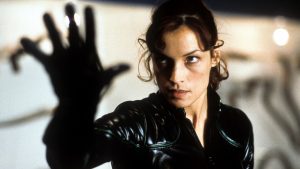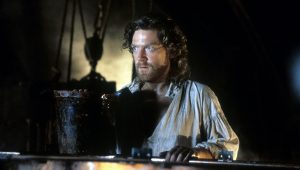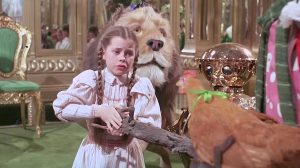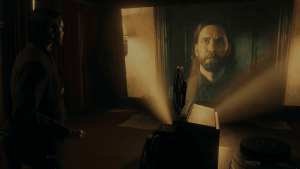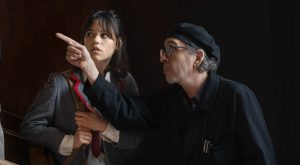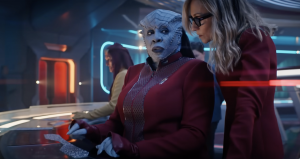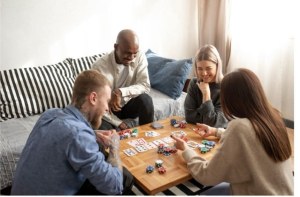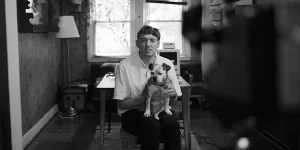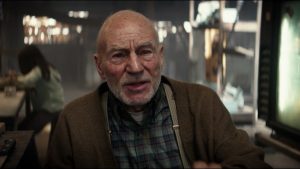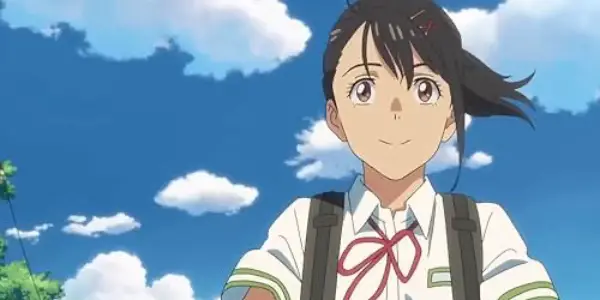
Anime Director and Writer, Makoto Shinkai, talks about his personal journey and artistry of Suzume. Suzume is one of this year’s best animated movies (in my opinion it is The BEST animated movie.) The movie showcases beautiful artistry and unique vision to propel a distinctive story about tragedy and loss that entertains and dazzles.
Makoto Shinkai talks of his influences, video games, mourning, loss and having an asteroid named after him!
Please note: this interview has been edited for clarity.
This Demetri Panos for Film Inquiry: It has been almost one year since Suzume debuted in Japan. Did you ever expect the movie to have this great global theatrical run with over $300 million and counting and box office?! Congratulations!
Makoto Shinkai: Frankly, wasn’t expecting this level of box office success, especially with the international audience. Partially because Suzume is very much grounded in this idea of the Tohoku earthquake that happened in 2011. And it’s a very, very mean localized, and by localized I mean, you know, specific to Japan type of incident, and even within the Japanese audiences, there were some polarizing opinions because some people thought, you know, how can you use a disaster like this as a source of entertainment but then there’s also a lot of positive commentary as well. But to think that internationally it would translate this well and risk being received by audiences is a surprise and not something on my mind when I was making it.
How old were you when you knew you wanted to be an artist?
Makoto Shinkai: Ironically, there was not any moment in my life where I decided I wanted to become a director. But I did realize I enjoy the process of making things and that was around 10 years old I want to say 10. So my parents they bought me this eight-bit computer. At the time, Nintendo was all the rage and all the kids had Nintendo systems. But for some reason, my parents opted to buy me a computer instead. So I didn’t have a Nintendo system. And of course, on my computer I wanted to play video games, but it was a rather minor platform compared to the Nintendo where there’s a whole library of games. So I had to actually program my own little tennis game on this computer so that I can play it. So that was when I realized I like making things.
Was there a movie or movies that may have inspired you?
Makoto Shinkai: Between when I was 10 I want to say sometime in middle school, I was heavily impacted by Hayao Miyazaki’s work specifically the Castle of Cagliostro, Nauiscaa, and Castle in the Sky, are some major films that really affected me and I remember saving up my allowance and buying VHS cassettes back then watching over and over.
source: Toho
I had read that you drew picture books for your school’s juvenile literature club. Can you describe what you drew back then? And did these books resemble Manga?
Makoto Shinkai: I honestly can’t recall, it’s over 30 years ago, but I think, faintly, I remember a story about two siblings, an older brother, and younger sister, they took objects and stuff around the house and would imagine making this imaginary ship and go out on journeys. And it didn’t even have an act 1, 2 or 3 or any kind of arc. It was just a narrative. I tried the manga thing or something like a manga, but I never finished it. But I think the conclusion was, I was able to draw and that I do like the idea of storytelling.
It’s no surprise, that your first job was working for a video game company. What did you do there?
Makoto Shinkai: I didn’t work on the video game or the contents itself as much as I did, Some of the opening movies, or even some of the package illustrations, what the audience would probably initially see when they pick it (the game) up. I did a lot of that stuff around the game.
Did any of your friends play the games you worked on? In which you tell them Hey, that’s mine.
Makoto Shinkai: Yeah, definitely, I would let everyone know. But at the same time, I was at the game company for five years, I want to say and we’ve worked on several games throughout that process. There’s one anecdote that comes to mind. There was a game that we played in high school. It was a fantasy RPG -role-playing game- that was on the eight-bit platform. There was a remake of this game and incidentally, our company got the job to help with the remake. The original game was very famous for its opening cutscene despite it being eight bits. Back then, what you could do and what you could express visually was quite limiting. Now that we were in the 90s, and we’re remaking this, I think there’s a huge anticipation of, what’s new opening going to look like? For me, it was, quite an interesting experience to be able to handle the new updated version of this opening cinematic for a game that I played a long time ago. The anticipation and expectation were quite high. Thankfully, when the fans of the original game saw the new opening, it resonated a lot! (with fans of the original game! a lot of the fans resonated with the original game because when they saw the new opening, the anticipation expectation was quite high.) I think I was able to help retain that spirit so to speak.
That’s fantastic! This is what inspired you to make movies?
Makoto Shinkai: As you can imagine, opening cinematics for video games is a few minutes at most, but through that process, I almost felt like I was making short films. That role in that company kind of equipped me with the bare minimum skills to I think, make a film.
Well, let’s be honest, sometimes those cinematics are better than the game.
source: Toho
Suzume is about the disaster. It’s about loss, mourning, and by the end hope. It is inspired by the Great East Japan Earthquake of March 2011. You’ve talked about a concept called mourning a place. Can you describe or explain that concept?
Makoto Shinkai: As you mentioned, the film deals with loss and to your point, this concept of mourning places that have either been abandoned or for whatever reason no longer part of human society and interaction. One of the reasons or kind of triggers I suppose, that led me to this conclusion is because; the idea of mourning a place or an object doesn’t really happen (or an object) doesn’t happen in Japan as much. Whereas, for example, if you build a new house, it’s very grand and celebratory. You invite a Shinto priest to come and bless it in some way. So there’s this ritual when something new is born. But when these houses are either taken down or abandoned or no longer needed for a reason, there’s no equivalent, so to speak.
Have you lost a place that you still mourn?
Makoto Shinkai: This (answer) is probably on a grander scale and beyond simply myself. There is not necessarily any one place per se. As a result of the 2011 earthquake, there have become uninhabitable areas, and in some ways are quarantined. There is a very kind of loose wording that the government or those institutions used to describe it would be; places difficult to return to. I think the intention to keep it a little bit vague. So, as a result of perhaps some of the radioactive fallout of the Fukushima power plant, but you don’t think about these places in your daily life and your daily routine. Occasionally when you’re either driving by, it’s a very eerie kind of feeling because all the roads and what’s immediately next to it is maintained. But you can tell, like right next to you, there are these places that are year over year kind of weathering and disappearing and in some ways,
I heard read a story about you. You were in production of Children Who Chased Lost Voices when the quake hit. Due to the devastation, many on your production were forced to spend the night at an elementary school. You yourself chose to take a very long walk home to be with your family, which is very honorable and commendable. In Suzume, a movie about disaster, there is both an elementary school and a stranger who appears to be a long walk when he meets Suzume. Is that at all a coincidence?
Makoto Shinkai: Having heard this question perhaps there’s an overlap that I did not realize at the time! I do want to say on the March 11 earthquake, I live within Tokyo. It sounds like this epic quest to get home. In reality it took, I want to say around one hour.
That is considered a long walk here in Los Angeles!
(Laughter)
Makoto Shinkai (cont): In walking home however, it was a very different cityscape than what I was used to seeing. What would usually be very lit up and lively, I think there was this certain mood as well as it actually being physically pitch black because of the electrics grid situation. So you know that that was something that was quite different from what I’m normally used to seeing, but I don’t know if it was grand enough to be able to juxtapose it with Suzume’s trip.
source: Toho
Suzume’s central story is about disaster. It’s a devastating disaster. How did you go about telling a story that was not completely depressing and filled with humor and heart and hope?
Makoto Shinkai: The film for me, it necessarily needed an element or component of fun. If I come out and announce Hey, I made a movie about the 2011 disaster and that was it, I think it would become a very dark and heavy film unnecessarily so. In order to ask audiences to exchange money and two hours of their time for some kind of experience, why would they pay money to revisit experiences and trauma that they’re trying to forget? So whether or not you know or are not too familiar with the 2011 earthquake, I wanted this to be a fun journey and experience for movie goers alike. Also, because we’re dealing with such a serious theme here, I wanted to make sure that there was a purpose or meaning for an animation director to view that incident through a different lens. I’m sure other storytellers can tell a much better story if we want to go in the dark direction. But, for an animation director to recall this and retell it, I think it needed a very different type of lens. So of course, there are certain messages and certain themes surrounding the 2011 earthquake, but structurally it was important that the entire film had room for the comic relief and lightheartedness.
Well, it worked. I can say that it worked very much. I’d like to talk about animation. So for me, Suzume is a beautiful hybrid of hand drawn and computer generated animation. Is it difficult to combine the two and make it appear seamless?
Makoto Shinkai: With regards to making the two formats of animation and expression feel seamless; I wouldn’t necessarily say it was like super, super difficult, or we had some brand new groundbreaking technology, but by any stretch of the imagination, and for better or for worse, Japanese animation is very much rooted in the 2d hand drawn using the filming the cells type of expression. But year over year, I think a lot of these artisans, I mean, they’re artisans in their own right, to be able to understand how to get the most out of that medium, are either getting older or leaving the industry. So there is this necessity to shift a little bit towards CG and newer styles of animating. So solving the how do we merge 2d and 3d is something that a lot of animation studios are aware of, and working on. And I wouldn’t necessarily say something that we invented for the purpose of this movie.
Well, it’s beautiful and seamless.
Is it true that you actually have an asteroid named after you?
Makoto Shinkai: I think it says that on Wikipedia, perhaps. And I myself was not aware of that until one of my fans told me that, hey, I saw on the internet, do you have an asteroid named after you? I don’t recall exactly how it happened. I think perhaps an amateur astronomer or someone found something and then maybe he or she was an anime fan and decided to name it after me.
source: Toho
Such responsibility! I don’t think I could handle it. Knowing there was an asteroid out there with my name on it, it would end up being the life ending asteroid and people would hate me for whatever little life they had left. Okay, so wrapping things up. You’ve been on perhaps one of the longest publicity tours! I take it a vacation is going to be an order sometime very soon. What are you going to do? Where are you going?
Makoto Shinkai: Ironically enough, after this stint of the PR tour, I’m going to fly back to Japan and we’re already developing a very high conceptual level, the next film! I have a meeting with my producer when I return! It’s actually in the back of my mind while doing this. I’m already thinking okay, what am I going to write? What Story am I going to tell? Having said that, I know it’s been a year since the Japanese theatrical release around November. The actual theatrical run went till I want to say…end of May or June-ish. So, it’s been about six months since my film is closed in theaters until now. There has been a bit of free time between. I did take one vacation to Hokkaido, which is the northernmost island in Japan to visit my parents which is there hometown.
Thank you very much for making and creating a beautiful movie. Personally, it’s my favorite animated movie of the year. I appreciate your time.
We want to thank Makoto Shinkai and his interpreter, “Mikey” for taking the time to speak with us!
Does content like this matter to you?
Become a Member and support film journalism. Unlock access to all of Film Inquiry`s great articles. Join a community of like-minded readers who are passionate about cinema – get access to our private members Network, give back to independent filmmakers, and more.
